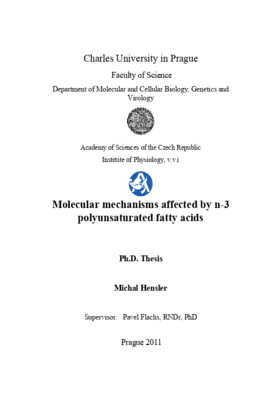Molecular mechanisms affected by n-3 polyunsaturated fatty acids
Molekulární mechanismy n-3 polynenasycených mastných kyselin
dizertační práce (OBHÁJENO)

Zobrazit/
Trvalý odkaz
http://hdl.handle.net/20.500.11956/47853Identifikátory
SIS: 84983
Kolekce
- Kvalifikační práce [19588]
Autor
Vedoucí práce
Oponent práce
Rossmeislová, Lenka
Dlouhý, Pavel
Fakulta / součást
Přírodovědecká fakulta
Obor
-
Katedra / ústav / klinika
Katedra genetiky a mikrobiologie
Datum obhajoby
14. 2. 2012
Nakladatel
Univerzita Karlova, Přírodovědecká fakultaJazyk
Angličtina
Známka
Prospěl/a
Tuková tkáň a její hormony hrají nezastupitelnou roli ve fyziologii savců. Při nerovnováze mezi příjmem a výdejem energie dochází k růstu tukové tkáně, a ke změně jejího sekrečního profilu. S obezitou jsou spojována mnohá onemocnění, jako kardiovaskulární onemocnění, dyslipidémie, hypertenze a inzulínová rezistence. n-3 polynenasycené mastné kyseliny s dlouhým řetězcem (LC n-3 PUFAs) z rybích olejů, hlavně eikosapentaenová (EPA) a dokosahexaenová (DHA) kyselina, zlepšují celkový lipidový metabolizmus a brání rozvoji obezity a inzulínové rezistence. Studie, prováděné na myších liniích náchylných k obezitě (C57BL/6), nám poskytují důležité poznatky, týkající se jejich vlivu na savčí tkáně a možného terapeutického využití. Tato disertační práce je založena na pěti publikovaných článcích (A-E). Tři práce se věnovaly problematice bílé tukové tkáně. V těchto pracích jsme ukázali, že bílá tuková tkáň je flexibilní orgán a LC n-3 PUFAs hrají důležitou roli v její biologii. Naše výsledky ukazují, že LC n-3 PUFAs ovlivňují množství tukové tkáně mechanizmy závislými jak na potlačení proliferace, tak i diferenciace tukových buněk (publikace A). Anti-obezitní efekt EPA a DHA může být ještě více umocněn mírnou kalorickou restrikcí (10%). Výsledky z publikace B dokazují, že lipidový katabolizmus a tvorba...
Adipose tissue and its hormones have an irreplaceable role in the physiology of mammals. The imbalance between energy intake and energy expenditure leads to the expansion of adipose tissue and changes in its secretion profile. With obesity are associated diseases including cardiovascular diseases, dyslipidemia, hypertension and insulin resistance, one of the major public health issues. Long-chain n-3 polyunsaturated fatty acids (LC n-3 PUFAs) from marine origin, mainly eicosapentaenoic (EPA) and docosahexaenoic (DHA) acids exert numerous beneficial effects, such as improvements of lipid metabolism and prevention of obesity and diabetes. Studies with obesity-prone model mice (C57BL/6) provide us important knowledge regarding their effect on mammalian tissues and to test potential therapeutic interventions. The thesis is based on five published studies (A-E). Three studies are focused on white adipose tissue. In these works we proved that adipose tissue is a flexible organ and LC n- 3 PUFAs are potent regulators of adipose tissue biology. Our results document that LC n- 3 PUFAs affect adipose tissue mass by a mechanism, which depends on counteraction of both, differentiation and proliferation of adipose cell (publication A). The anti-obesity effect of EPA and DHA could be magnified by mild calorie...
